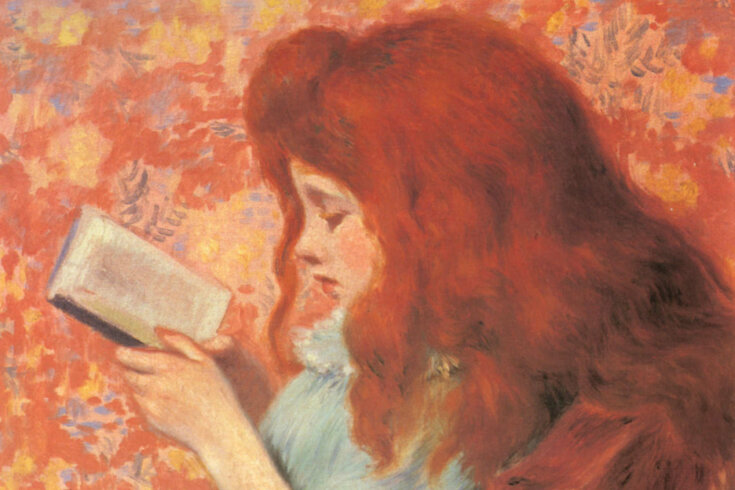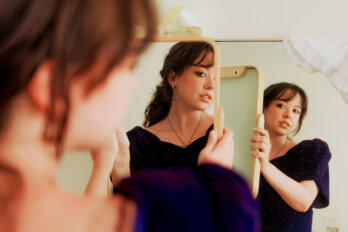M y father grew up in Africa. He loved Rudyard Kipling—and the Just So stories especially. On his shelves, there was a handsome uniform edition of Kipling’s works, with dark-burgundy dust jackets. My father was an actor for a while, and when he read to me from Kipling, you could hear something of the actor he had been in his voice. He relished the cadences of those stories.
Was he remembering his childhood—his father reading to him in 1950s Johannesburg, the landscape of Africa—while, in 1980s Surrey, he invoked “the great grey-green greasy Limpopo River, all set about with fever trees” or described Yellow-Dog Dingo’s skittering pursuit through the bush? Was he remembering being playfully so cautioned himself when, in “How the Whale Got His Throat,” he admonished his small audience: “You must not forget the suspenders, Best Beloved.”
“Best Beloved.” The phrase that describes how every child, wrapped in a story read by a parent, will feel in that moment. It’s handed down: generation to generation. My father to me. His father to him. Somewhere, far behind that, is Kipling—not a figure in the late-Victorian literary firmament but a man, miles from the place of his birth, reading fondly to his daughter.
We pass these stories, hand over hand, voice to voice, as stories have always been passed. Each generation reads the old ones and finds new ones that will in turn be passed on. As a child, I was read Alexander and the Terrible, Horrible, No Good, Very Bad Day; The Tiger Who Came to Tea and Mog the Forgetful Cat; Dogger; Burglar Bill; Green Eggs and Ham; Burnie’s Hill. I read those same books to my children. They in turn added to our family canon the works of Julia Donaldson and Jon Klassen, the Harry Potter series and Diary of a Wimpy Kid, S. F. Said’s Varjak Paw, Piers Torday’s Last Wild series, Katherine Rundell’s The Wolf Wilder. Will they read some of those books to their children? I hope so.
I still cherish the photograph I took of my son, then aged four, sitting with Judith Kerr, then aged ninety-four, at her home in Barnes. (I went to interview her, and the child care fell through.) Judith’s gone now, but Mog and that hungry tiger are still with us—and will be for many decades to come.
M artin Amis, a writer I revere, once said something uncharacteristically foolish. Talking to the novelist Sebastian Faulks in 2011, he said: “People ask me if I ever thought of writing a children’s book. I say, ‘If I had a serious brain injury I might well write a children’s book,’ but otherwise the idea of being conscious of who you’re directing the story to is anathema to me, because, in my view, fiction is freedom and any restraints on that are intolerable. I would never write about someone that forced me to write at a lower register than what I can write.”
The idea that children’s writing is a lower form—a brain-injured version of writing for adults, as Amis caricatured it—is as persistent as it is misguided. Children’s literature isn’t a defective and frivolous sidebar to the grown-up sort. It’s the platform on which everything else is built. It’s through what we read as children that we imbibe our first understanding of what it is to inhabit a fictional world, how words and sentences carry a style and tone of voice, how a narrator can reveal or occlude the minds of others, and how we learn to anticipate with excitement or dread what’s round the corner. What we read in childhood stays with us. No less a figure than G. K. Chesterton was to say in 1924 that the children’s fantasy The Princess and the Goblin had “made a difference to my whole existence.” It really matters.
So what do we mean by children’s literature anyway? Most children’s books have children or adolescents as their protagonists, but not all of them. Most children’s books are simpler in their language than books for adults, but not all of them. Most—as time goes on—have come to be very directly addressed to child readers, but not all of them. Many of the classics, it strikes me, and I include Alice’s Adventures in Wonderland in this, are scarcely books for children at all. The boundaries are extraordinarily blurry. And the question of what children’s literature is for is a question that haunts the whole history of children’s writing, and to which every book finds a different answer—or dares to find no answer at all.
The idea that there is a distinctive literature for children has come and gone over the years. Some of the greatest children’s writers are firm in disavowing the very categorization. Many classics of what we’d now call children’s literature weren’t seen as such when they were first published. We might think of fairy tales, in the same breath as nursery rhymes, as being a basic form of children’s writing—but the great collectors of fairy tales, like Perrault and the Grimms, originally targeted their texts at sophisticated salonnières, or cultural historians.
An account of the childhood reading of the past would take in sensation literature and penny bloods as much as educational chapbooks. In the nineteenth century, there was nothing to say that Heidi or The Swiss Family Robinson or Little Lord Fauntleroy were for children, and nothing to indicate that adults weren’t reading them with enthusiasm. There was no children’s section of the bookshop. It wasn’t until the early twentieth century that children’s publishing really became a distinct sector of the industry.
Over the years, it has segmented, as established markets do, drawing lines between learn-to-read books, read-aloud books, chapter books, books aimed at preteens and young teenagers. Those distinctions acquired a vocabulary: professionals now, for instance, talk of MG (“middle-grade”: ages eight to twelve) and YA (“young adult”: thirteen to eighteen). But age ranges have always been fuzzy approximations of the contract between individual writers and individual readers. Some nine-year-olds will read Homer or Charlotte Brontë; some seventeen-year-olds will be happy with Harry Potter. A comprehensive history of children’s reading, as opposed to children’s writing, would likely include, too (at least for my generation), such treasures of the parental bookshelves as Agatha Christie, Wilbur Smith, Jackie Collins, and the smutty bits of Shirley Conran or Harold Robbins. I try not to fuss too much here about these distinctions. In our own age, the growth of YA has further blurred the boundaries; a significant segment of the audience for so-called YA is now women in their early thirties. This returns us, perhaps, to the situation of more than a century before.
To state something obvious but easy to lose sight of: what all children’s books have in common is that they are not written by children. They are written for, or about, children. That makes them more psychologically complex and culturally interesting artifacts than their grown-up counterparts. They come to be a document not of how children are but how adults imagine children to be, or how they imagine they want them to be. They very often, particularly in their early years, had a design upon their readers: they wanted to educate first and offer delight (if at all) only incidentally, as a means to that end. But even when they did not have so palpably didactic a design, they have inescapably reflected adult anxieties about childhood—our sentimental projections, our recuperative fantasies.
So a children’s book will often address more than one audience. It will be written from an adult to a child, from an adult to the adult who will be reading to that child, and, in some sense, from the child that the author once was to the adult that they now are. There’s a lot at stake. Wordsworth minted the phrase “the child is father of the man,” but the sentiment it expresses is much, much older. Human beings are storytelling animals, and it is out of the stories we tell ourselves that we make sense of the world. The books of our religions, and the founding narratives of our civilizations, are storybooks.
T he awareness of storytelling’s power, and the sense that children are particularly vulnerable to it at a vital stage in their development—“impressionable,” as the wax-tablet metaphor descending to us from Plato via Locke has it—is a central theme of this history. Moral anxieties over the contents of children’s books are as old as children’s books themselves. Children’s writing tells us not only how children experience the world but also how adults conceive the world of children. It tells us about childish aspiration and adult fears and longings. And it shapes the adults that the children who delight in it are to become.
Take, just as one example, the way that children’s books have mapped the idea of naughtiness. Through much of the eighteenth and nineteenth centuries, the prime virtue of the child was obedience to its parents. To be “naughty,” as in the older sense of the word, was to be sinful, and the wages of sin are death. But even the most basic accommodation with reality recognizes that children are naughty. What had been a term of disapproval became a central virtue of children’s stories. Naughtiness—provided it was accompanied by a good heart—was okay, even to be celebrated. Some rules were made to be broken.
Bunking off school, sneaking out of the window at night, raiding the larder, pranks and practical jokes: these are the meat and drink of the child protagonist. The magic phrase that activates the Marauder’s Map in Harry Potter and the Prisoner of Azkaban is: “I solemnly swear I am up to no good.” Having started out as a tool for cementing adult authority, children’s stories came to allow children to imagine worlds in which they resisted or subverted it more daringly than they possibly could in real life. And they allowed adults to indulge that fantasy—to wink at naughtiness.
Another thing that Martin Amis said—“fiction is freedom”—seems to me to be especially apposite. In the narrative spaces that these books create, adults and children meet each other travelling in opposite directions. These spaces offer different sorts of freedom. For the child reader, it is a fantasy of (to borrow from Isaiah Berlin’s “Two Concepts of Liberty”) positive liberty: freedom to. A child is given the chance to identify with a protagonist who has freedom to act in the world in a way that few children do in their own lives. That’s why, one way or another, and with only relatively rare exceptions, the parents have to be got out of the way. You’ll meet in these books any number of orphans or children severed from their parents by circumstance—whether something as worldly as a colonial posting overseas, or a place in the dormitory of a boarding school, or as unworldly as a portal to a fantastical universe. The child reader can dream of a temporary, but usually safely bounded, version of adulthood.
For the adult reader or, perhaps more pressingly, the adult writer, the imaginative spaces of children’s stories represent negative liberty: freedom from. Freedom from adult responsibility, freedom from loss and sorrow, freedom from the drudgery of the workaday round. The children’s writer is able to imagine themself as a child again: to recreate the childhood they remember or, as often, to concoct a compensatory version of it that will be braver, happier, less dull, less loveless. That’s the core of this strange territory. The most effective writers for children almost always seem to be the ones who have invested most in the writing emotionally. Often, they are writing from a wound—whether a wound sustained in childhood or the wound of having had to leave it behind in the first place.
That’s why a surprising constant in a literature associated with ideas of freedom and innocence is grief. Many of the most enduring and most moving of these stories have a pulse of sadness in them or behind them. To be a child is to know that you have to grow up. To be an adult is to know that you have to die. And to be a parent is to be in a permanent state of mourning: as you watch your child grow up, you are saying an irreversible farewell to the child that they were, day by day, month by month, year by year.
There’s grief, too, in the backstories of many of these books. It’s not brain damage that makes you a children’s writer—but for a lot of the writers, there was damage of another sort. The people who have written for children often have strange and troubled and sometimes sad lives. Creation serves a need, and it’s seldom just a need for a royalty statement.
Many of the great children’s stories started their lives being addressed to particular children. The origin myth of Alice’s Adventures in Wonderland has it addressed to ten-year-old Alice Liddell. Barrie’s Peter Pan stories were directed at the childless author’s friends’ children, George and Jack Llewelyn Davies. The Wind in the Willows started life as the improvised bedtime stories Kenneth Grahame told his son Alastair. Watership Down had its origins in the tales Richard Adams spun to his daughters to beguile long car journeys. And sometimes the child whom the writer was addressing, the child the writer yearned to preserve and protect, was him- or herself.
Those children, as children do, outgrew the images of themselves fixed in the pages. It often cost them their happiness. Sometimes, it cost them more. In disconcertingly many cases, they would not live to find out what it would cost them. The Just So stories were originally told by Kipling to his first child, Josephine, or “Effie.” “There were stories meant to put Effie to sleep, and you were not allowed to alter those by one single little word.” Effie was “Best Beloved.” Effie died when she was six years old.
Yet the stories that were told to Effie and Alastair Grahame and all those real children like them have outlived their original audiences and outlived their authors. They remain, even if shadowed by sadness, bright objects. There is adventure in them—and love and laughter and fun; they place their readers in each generation on the brink of new worlds, new possibilities.
Excerpted from The Haunted Wood: A History of Childhood Reading. Copyright © 2024 Sam Leith. Reprinted by permission of Sutherland House Books.





